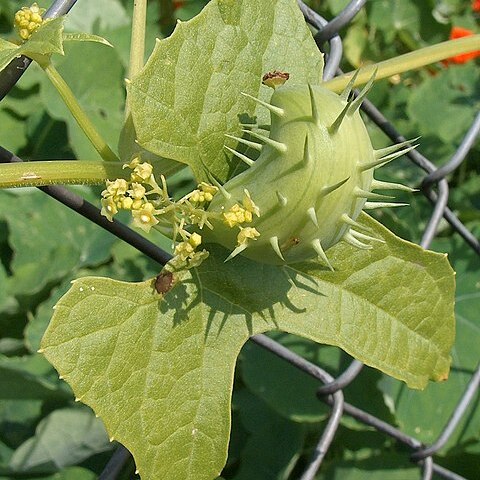Annual or perennial herbaceous climbers, glabrescent; monoecious; cultivated or running wild. Probract absent. Tendrils unbranched or 2-or more-branched. Leaves simple, unlobed or deeply lobed to almost foliolate. Flowers small, pale greenish yellow, petals free or hardly connate at base. Male inflorescences racemose or paniculate. Male flowers: receptacle-tube small, shallow; sepals small, subulate or linear; stamens united a short central column, anthers connate into a head or into a horizontal (peltate) ring, opening with a horizontal slit; disc (pistillode) absent. Female flowers solitary or one co-axillary with male inflorescence; perianth as in male flowers; ovary narrowly ovoid or ellipsoid, somewhat oblique, rostrate, style short, stigma hemi-spherical, ovules 1 to many per locule; staminodes absent. Fruit oblique, ovoid(-oblong), various of shape, not juicy, glabrous or mostly with soft spines, 1-or more-locular, 5-to many-seeded, when ripe elastically opening and jetting the seeds away, leaving central column and placenta. Seeds few or several, compressed, angular, often toothed at the end(s), faces smooth or rough, margin distinct (wing-like), edge irregularly coarsely toothed.
Monoecious, tendriled vines; stems 5-to 10-sulcate. Leaves petiolate, simple to pedately 3-to 5-foliolate, with or without glands at base; tendrils simple or to 5-branched. Staminate flowers in racemes or narrow panicles, axillary; calyx cupulate, 5-lobate; corolla greenish-yellow or white, rotate, 5-lobate; stamen 1, the anther forming a capitate horizontal ring, the theca unilocular. Pistillate flowers solitary or few in same axils as the staminate flowers, but larger; ovary obliquely ovoid, rostrate, 1-3 carpellate, the style 1, the stigma subglobose. Fruit obliquely ovoid, often echinate, explosively dehiscent or indehiscent; seeds few to many, erect, ovoid to angular, somewhat compressed, the margin often appendaged, the testa rugose or smooth.
Herbs, climbing, annual or perennial. Tendrils simple or 2-to many fid. Leaves undivided, divided, or pedately 5-7-foliolate. Plants monoecious. Male flowers in raceme or panicle; calyx tube cup-shaped or cupular; segments 5, subulate, sometimes almost obsolete; corolla rotate, 5-partite; segments broadly ovate-oblong, usually acute; stamen 1; filament very short; anther horizontal, 1-celled, circular. Female flowers solitary, binary, or 3-fasciculate; calyx and corolla as in male flowers; ovary ovoid, 1-locular; style very short; stigma large, orbicular. Fruit ovoid or reniform, ± fleshy, setose or setiform, rarely glabrous. Seeds few to numerous, compressed, angled, 2-lobed at apex and base.

